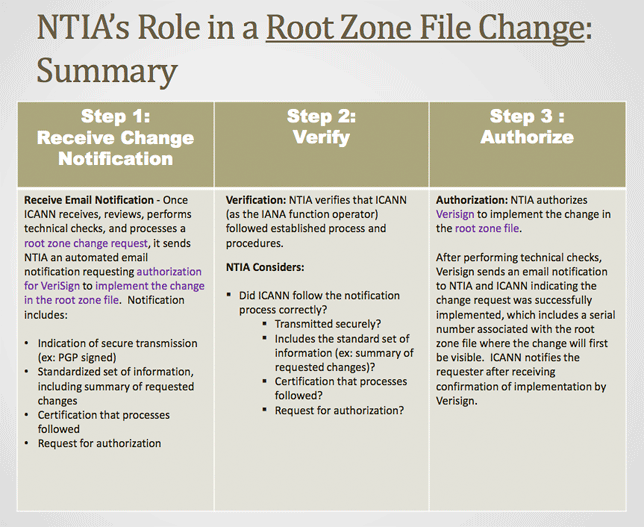

|
||
Kieren McCarthy reporting in the Register: “The US government has posted a step-by-step guide to how it authorizes changes to the internet’s root zone—the heart of the world’s domain-name system. The 16-page slide deck published by the Department of Commerce’s National Telecommunications and Information Administration (NTIA) sheds light on what has been a contentious and largely secret process for the past 15 years.”

Sponsored byVerisign

Sponsored byIPv4.Global

Sponsored byDNIB.com

Sponsored byVerisign

Sponsored byCSC

Sponsored byWhoisXML API

Sponsored byRadix

One might wonder why there is no step 4 in which NTIA verifies that Verisign has correctly done what was requested. (By-the-way, Verisign, as a top level domain franchisee and root server operator does have a signficant conflict of interest.)
In addition Kieren doesn’t indicate that these steps are not formally imposed on NTIA. Rather, NTIA is free to modify or abandon these steps at any time.
For example, NTIA is utterly free to skip steps 1 and 2 entirely and to issue instructions of its own creation to Verisign to put into the root zone file.
And NTIA still has the latent power to ignore or modify anything it receives from ICANN in step 1.
I believe that this is more than conjectural, that NTIA has overridden ICANN directions with regard to the .us ccTLD. Moreover, NTIA is a creature of the US government and would be compelled to override ICANN should Congress or an Executive order require it.
I also kinda wonder at the formalities regarding the email exchange with ICANN compared to the lack of such explicit formalities with regard to communications with Verisign.
Also there seems to be no closure in this process that indicates whether any or all of the root server operators have picked up the changes and deployed them. (Root server operators are not under any formal legal compusion to pick up the ICANN/NTIA/Verisign root zone file or to publish it without changes. They do so out of inertia and a desire to avoid creating inconsistencies, but that is a choice of thier own.)